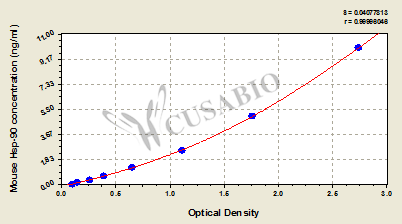CUSABIO's Hsp90 mouse ELISA kit is an in vitro enzyme-linked immunosorbent assay for the quantitative measurement of mouse Hsp90 in serum, plasma, or tissue homogenates. This assay uses an antibody specific to mouse Hsp90 coated on a 96-well plate. Hsp90 present in a sample is bound to the wells by the immobilized antibody after adding the sample to the wells. Biotinylated Hsp90 antibody is added to the wells, forming an antibody-analyte-antibody complex. HRP-conjugated avidin is pipetted to the wells and binds to the complex. A TMB substrate solution is added to the wells and color develops in proportion to the amount of Hsp90 bound. The addition of Stop Solution changes the color from blue to yellow, and the intensity of the color is measured at 450 nm using a microplate reader.
Hsp90 is a highly abundant and ubiquitous molecular chaperone essential for many cellular processes including cell cycle control, cell survival, hormone, and other signaling pathways. Hsp90 takes part in the proper folding and maintenance of its client proteins in eukaryotic cells including protein kinases, transcription factors, and E3 ubiquitin ligases, thus positioning as a central regulator of cellular proteostasis. It is also important for the cell's response to stress and is a key player in maintaining cellular homeostasis.






